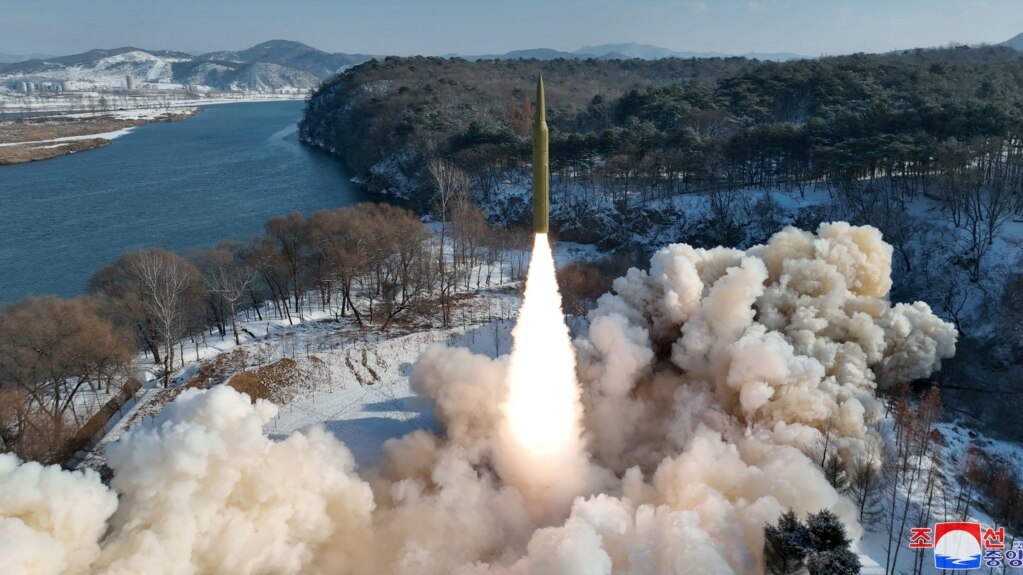North Korea announced earlier this week it had carried out a test of a hypersonic weapon attached to a missile. It was not the first time the country has claimed to carry out such a test. North Korean officials announced the first one in 2021.
Several other nations have confirmed they are also developing and testing hypersonic weapons. What are these weapons and which countries have them?
What is a hypersonic weapon?
A hypersonic weapon is designed to fly at superfast speeds equal to at least five times the speed of sound, known as Mach 5. This is about 6,200 kilometers per hour. These weapons are similar to ballistic missiles, which can also reach hypersonic speeds.
But, the difference with hypersonic weapons is that they are highly maneuverable. This means they are easy to direct and control in flight. Ballistic missiles generally have set paths with very little maneuverability. Since the path, or trajectory, of hypersonic weapons can be changed, they are harder to identify. This means they are difficult to destroy with existing missile defense systems.
What kinds of hypersonic weapons currently exist?
The two main kinds of hypersonic weapons are hypersonic glide vehicles and hypersonic cruise missiles.
Hypersonic glide vehicles launch from a rocket. The glide vehicle then separates from the rocket and “glides” at speeds of at least Mach 5 toward a target.
Hypersonic cruise missiles do not have a glide vehicle and are powered by high-speed, air-breathing engines.
How do hypersonic missiles operate?
Hypersonic missiles generally launch warheads at speeds of at least Mach 5 while traveling at fairly low altitudes. Newly developed hypersonic weapons fly higher than less speedy missiles, but lower than intercontinental ballistic missiles. Hypersonic weapons are more difficult to identify and shoot down.
How far along is North Korea’s development?
North Korea's first hypersonic missile test, carried out in 2021, used a glider-shaped warhead. Another launch, in 2022, involved what South Korean military officials said was a kind of ballistic missile warhead with maneuverability to hit a target.
North Korean state media said the country’s latest launch came on January 14. It aimed to test the performance of a new multistage, solid-fuel engine attached to a hypersonic warhead.
North Korea described the test as a success. South Korean military officials said the missile flew about 1,000 kilometers before landing in waters between the Korean Peninsula and Japan.
International experts have said North Korea is interested in hypersonic technology because it can be used to distantly deploy weapons while avoiding missile defense systems. North Korea could, for example, use such weapons to target U.S. military bases in Japan and Guam.
Who leads the hypersonic race?
The United States, Russia and China are all developing hypersonic weapons. Additional nations are carrying out research, while others have claimed tests that have not been confirmed.
U.S. military and intelligence officials say China is building and testing both hypersonic cruise missiles and hypersonic glide vehicles. U.S. officials say China is believed to have carried out “hundreds” of hypersonic weapons tests between 2016 and 2021.
Reuters reported on one Chinese test in 2021. A hypersonic glide vehicle flew through space and circled the world before heading down toward its target, the news agency said.
Also in 2021, Russia successfully tested a hypersonic cruise missile. President Vladimir Putin described the launch as the start of a new generation of missile systems.
The United States confirmed in September 2021 it had tested an air-breathing hypersonic weapon. The next year, the U.S. military requested $3.8 billion to develop hypersonic weapons, plus another $246.9 million for hypersonic defense research. U.S. hypersonic weapons can be armed with additional warheads.
The Congressional Research Service describes the U.S. Army’s Long-Range Hypersonic Weapon as “a ground-launched missile equipped with a hypersonic glide body and associated transport, support, and fire control equipment.” The Army says such weapons are designed to “reach the top of Earth’s atmosphere” and remain just out of reach of missile defense systems.
I’m Bryan Lynn.

